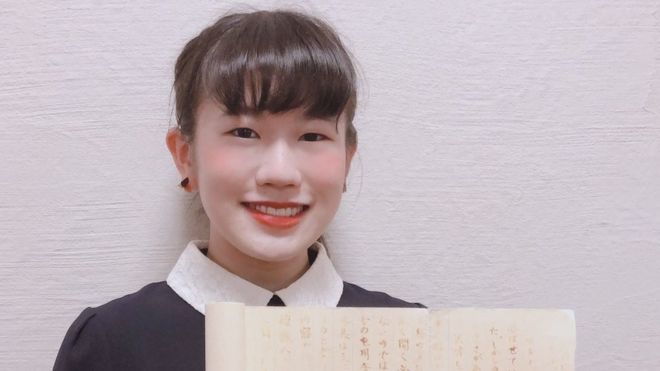A Japanese student of ninja history who handed in a blank paper was given top marks - after her professor realised the essay was written in invisible ink.
日本一名研究忍者历史的学生论文交了“白卷”,却得到了最高分,因为教授发现这篇文章是用隐形墨水写的。
Eimi Haga followed the ninja technique of "aburidashi", spending hours soaking and crushing soybeans to make the ink.
羽贺英美采用了一种忍者“烤墨纸”技术,她花费数小时浸泡、研磨豆子来制作墨水。
The words appeared when her professor heated the paper over his gas stove.
教授把她的论文放到煤气炉上方加热后,论文就显示了出来。
"It is something I learned through a book when I was little," Ms Haga told the BBC. "I just hoped that no-one would come up with the same idea."
羽贺英美告诉英国广播公司说:“这是我小时候从一本书中学到的。我只是希望自己的想法独一无二。”
Ms Haga has been interested in ninjas - covert agents and assassins in medieval Japan - since watching an animated TV show as a child.
在小时候看过一部动画片后,羽贺英美一直对忍者(中世纪日本的秘密特工和刺客)很感兴趣。
After enrolling at Mie University in Japan, the first-year student took a class in ninja history, and was asked to write about a visit to the Ninja Museum of Igaryu.
入读日本三重大学后,这位大一新生选了一门关于忍者历史的课,教授要求学生们写一篇参观伊贺市忍者博物馆的文章。
"When the professor said in class that he would give a high mark for creativity, I decided that I would make my essay stand out from others," she said.
她说:“教授在课堂上富有创造力的文章会打高分,我决定让我的文章脱颖而出。”
"I gave a thought for a while, and hit upon the idea of aburidashi."
“我想了一段时间,突然想到了‘烤墨纸’这个主意。”

Ms Haga, 19, soaked soybeans overnight, then crushed them before squeezing them in a cloth.
19岁的羽贺英美将大豆浸泡一夜,然后将其碾碎,再用布将其挤压。
She then mixed the soybean extract with water - spending two hours to get the concentration right - before writing her essay with a fine brush on "washi" (thin Japanese paper).
然后,她把大豆提取物加水搅拌,花了两个小时让浓度适宜,然后用细毛笔在“和纸”(日本的薄纸)上写了论文。
Once her words had dried, they became invisible. But, to ensure her professor didn't put the essay in the bin, she left a note in normal ink saying "heat the paper".
笔迹干了之后,上面的文字就会消失。但是,为了确保教授不会把论文当成垃圾扔掉,她用普通墨水写了一张纸条,上面写着“把纸加热看看”。
The professor, Yuji Yamada, told the BBC he was "surprised" when he saw the essay.
教授山田裕二告诉英国广播公司说,他看到这篇论文时感到“很惊讶”。
"I had seen such reports written in code, but never seen one done in aburidashi," he said.
他说:“我见过用代码写的论文,但从未见过用‘烤墨纸’写的。”
"To tell the truth, I had a little doubt that the words would come out clearly. But when I actually heated the paper over the gas stove in my house, the words appeared very clearly and I thought 'Well done!'
“说实话,我有点怀疑这些文字是否能清楚地显示出来。但当我在家里的煤气炉上加热这张纸时,上面的字看得很清楚,我心里想,‘干得漂亮’!”
"I didn't hesitate to give the report full marks - even though I didn't read it to the very end because I thought I should leave some part of the paper unheated, in case the media would somehow find this and take a picture."
“我毫不犹豫地给这篇论文打了满分——尽管我没有把它读到最后,因为我觉得我应该留出一部分未加热的纸张,万一有媒体知道这件事想拍照呢。”
As for the essay itself, Ms Haga said it had more style than substance.
至于这篇论文本身,羽贺英美表示,其形式大于内容。
"I was confident that the professor would at least recognise my efforts to make a creative essay," she said.
她说:“我相信教授至少会认可我为写一篇有创意的论文所付出的努力。”
"So I wasn't really worried about getting a bad score for my essay - though the content itself was nothing special."
“所以我并不怎么担心论文会得低分,尽管内容本身很普通。”


